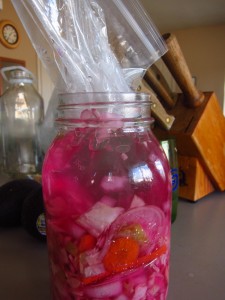Today we have the benefit of refrigeration to keep our food fresh. This is a relatively new occurrence. As little as 100 years ago many Americans used an icebox. They literally would get ice delivered to their home. Perhaps you have heard of the phrase, “the ice man cometh”. If the ice ran out, the food went bad.
Long before using cool temperatures to keep food fresh, techniques such as salting, pickling, and fermentation were used. Fermentation is very effective and has some pleasant side benefits. Beer and wine are the most popular fermented items today (yes, beer is a health food if it is not Pasteurized) Others include sourdough bread, yogurt, buttermilk, kombucha, tempeh and miso.
Foods that are fermented are rich in probiotic cultures. These probiotics are essential to a healthy digestive system. Old world cultures such as the Europeans, Russians, and Japanese have known about the benefits of fermented food for centuries. Do you want to save money by avoiding visits to the doctor or missing work because you are sick? Consider including fermented foods in your regular diet to help cleanse your digestive tract.
Learning to fermented on your own food is a valuable skill. Very few foods available in grocery stores contain live cultures. This is thanks to our good friend Louis Pasteur. Pasteur developed a process of heating food briefly to kill pathogens. While this has the effect of helping prevent food from spoiling, it also wipes out beneficial probiotics.
The High Country Conservation Center in Frisco, Colorado, recently held a workshop on fermented foods. Cassidy Callahan from HC3 presented the use of the brining technique to prepare Kim chi. Brining involves using a salt solution to ferment food. Fermentation is an an-aerobic process. Air must be kept out and gases produced in the process must be permitted to escape. A low tech and a very effective solution to this problem is a Ziploc bag filled with water. By placing the water filled bag on top of the food being fermented a one-way seal is created.
Callahan led the group through the simple process of chopping some vegetables, soaking them in salt water, and waiting patiently for a few days. In this case, the recipe called for cabbage, both green and red, onion, radish, carrots, and some fresh ginger, chilies, and garlic.
A brine of 4 tablespoons of salt to 1 quart of water is used to soak the chopped vegetables. Four hours is sufficient soaking time, and overnight is preferred. Next the vegetables are transferred to a jar, packed down to remove any air pockets, and covered with brine. Finally, the one way seal is put on top and the jar is left to rest for 4-5 days. When the Kim chi reaches a pleasing taste, excess brine is drained off and the Kim chi is ready to be enjoyed.
Two websites that are particularly helpful are Wildfermentation.com and Domesticdiva.ca. Both have blogs with news and recipes about fermentation. Homemade Kim chi, sauerkraut, yogurt, and kombucha are easy to make and a delicious part of healthy eating. These good friends can help you stay healthy for years to come.
MGH Tags: cleanse, skin
 Mediterranean Diet Recipes
Mediterranean Diet Recipes
 Categories:
Categories:  Tags:
Tags:
Recent Comments